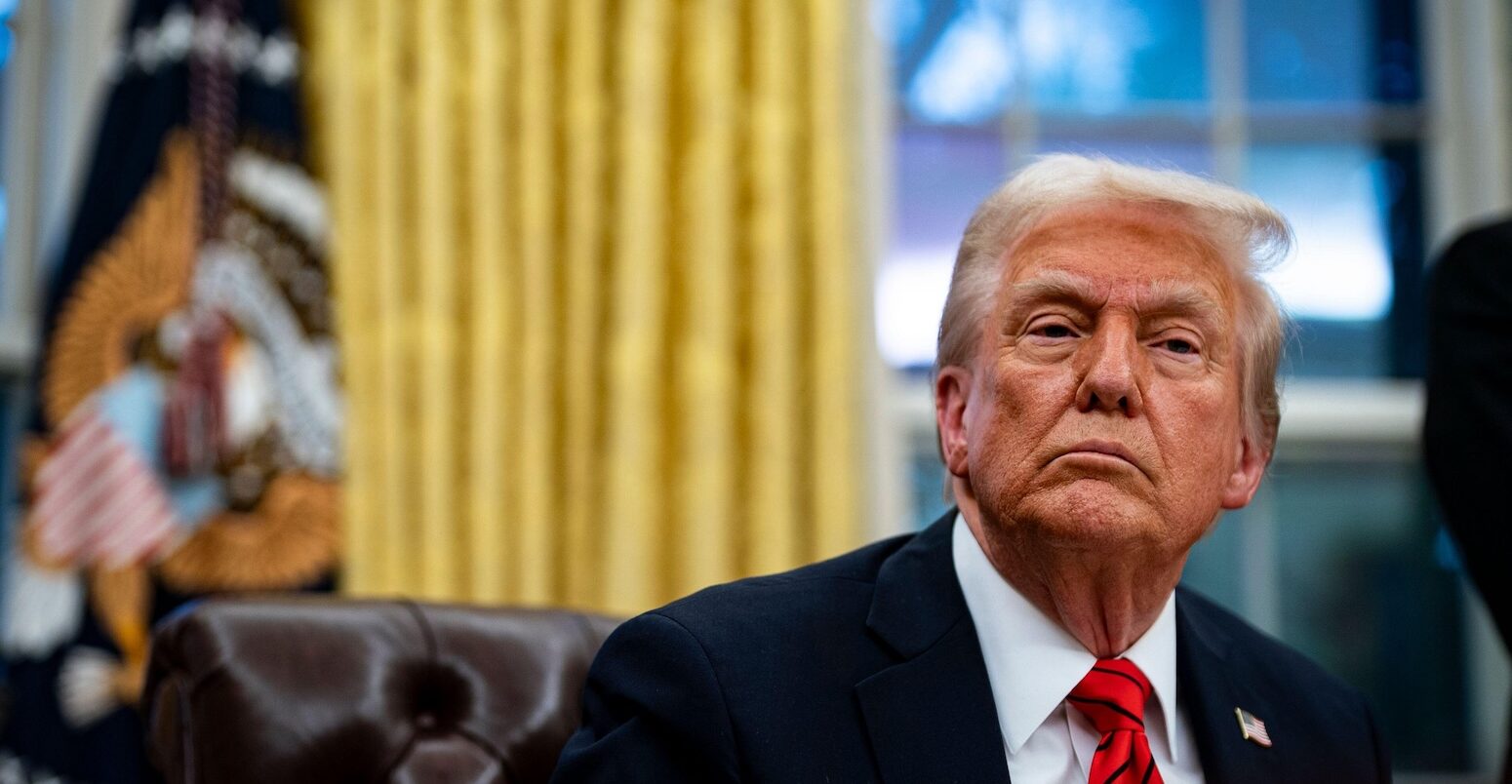
Experts: What do Trump’s tariffs mean for global climate action?
Josh Gabbatiss
03.27.25Josh Gabbatiss
27.03.2025 | 3:28pmThe Trump administration in the US has imposed tariffs on all imports from China, Mexico and Canada, as well as on steel, aluminium and cars from around the world.
In response, the US has been hit with retaliatory tariffs from major trading partners, including the EU.
US president Donald Trump has said he intends to launch a further round of reciprocal tariffs on 2 April, targeting a broader range of countries.
This escalating “trade war” is expected to slow global growth and has also triggered warnings of a US recession.
Global energy flows and efforts to tackle climate change are already being affected by the escalating trade tensions.
The tariffs are expected to disrupt the global trade in clean technologies, from electric cars to the materials used to build wind turbines.
At the same time, as high-emitting industries face higher costs, some commentators have suggested that tariffs could hamper US plans for fossil-fuel expansion.
And as clean technology becomes more expensive to manufacture in the US, other nations – particularly China – are likely to step up to fill in any gaps.
Carbon Brief has asked a range of researchers and policy experts what they think Trump’s tariffs could mean for global climate action and energy supplies.
These are their responses, first as sample quotes, then, below, in full:
- Dr Kyle Chan: “With US automakers struggling to compete, Chinese electric vehicle companies will likely gain a stronger position.”
- Elisabetta Cornago: “China may redirect its exports towards the relatively open EU market, challenging homegrown clean-tech industries at a time when the EU is trying to support and revitalise them.”
- Dr Bentley Allan and Dr Tim Sahay: “G7 and G20 countries are strengthening their domestic economies with deficit financing and directed investments into strategic sectors, such as green and digital sectors”
- Alex Muresianu: “A less productive US economy, which must pay higher prices for key inputs, is one that can spare fewer resources to address climate change.”
- Antoine Vagneur-Jones: “The administration’s fondness for data centres requires significant grid investment and yet the US relies on its neighbours for its supply of large power transformers.”
- Jimena Blanco: “The US is mainly or wholly import-reliant for around four-fifths of its identified 50 critical minerals, including from its partners Canada and Mexico.”
- Dr Simi Thambi: “An increase in trade protectionism is not good for climate action.”
- Robert Rozansky: “One upside to Trump’s trade war is that it might stymie his efforts to push US liquified natural gas (LNG) expansion into overdrive.”
- Chris Severson-Baker: “The Canadian oil and gas lobby…has been using this moment to make the case for more oil and gas production and infrastructure.”
- Anne-Sophie Corbeau: “Trump’s tariffs have already had an impact on LNG trade…China has not imported a single US LNG cargo since 6 February.”
- Avantika Goswami: “Tariffs – if imposed widely – may hurt the exports of countries like India, which nurture aspirations to mimic China’s role as an exporter of green goods.”
- Tu Le: “If manufacturers have to move multiple factories, that changes, reduces or eliminates what would have likely been more investment in research and development for clean energy vehicles.”
- Ellie Belton: “A more unpredictable US could create opportunities for the UK and EU to attract low-carbon investment and gain a competitive edge in the energy transition.”
- Eileen Torres Morales: “The effects of Trump’s tariffs on the global transition to green iron and steelmaking are still uncertain.”
- Dr Aurélien Saussay: “When faced with increased economic pressures from tariffs, countries could be more tempted to relax environmental standards to maintain competitiveness.”
 Dr Kyle Chan
Dr Kyle ChanPostdoctoral researcher and author of High Capacity
Princeton University
Trump’s tariffs will likely have wide-ranging effects on China’s clean-tech industry and global climate progress. Higher tariffs on China will directly impact US imports of Chinese clean tech goods, such as lithium batteries, which reached $1.9bn in December 2024.
Chinese solar manufacturing firms will also be hit indirectly through tariffs on production sites in south-east Asia, which collectively supplies 80% of US solar imports. Meanwhile, China’s retaliation could disrupt US access to critical minerals for its own clean-tech industry. This includes graphite for battery anodes and rare earth metals for wind turbines.
The impact on China’s electric vehicle industry in particular will be consequential, albeit less direct. Chinese electric vehicle imports to the US, which were already minimal, will not be significantly affected by Trump’s new tariffs.
However, the broader disruption to automotive supply chains across Mexico and Canada – along with rising steel and aluminium costs – will weaken the ability of US automakers to transition to electric vehicles. This will benefit Chinese electric vehicle makers, which continue to innovate and drive down costs.
With US automakers struggling to compete, Chinese electric vehicle companies will likely gain a stronger position, not just in China’s domestic market, but globally as well.
 Elisabetta Cornago
Elisabetta CornagoSenior research fellow, EU energy and climate policy
Centre for European Reform
The Trump administration is walking back on US climate commitments, both domestically by threatening to cut back Inflation Reduction Act (IRA) support for clean-tech industries and internationally, [by] withdrawing from the Paris Agreement. US tariffs can also affect climate action and the energy transition globally, hitting global value chains for clean technologies.
The Trump administration has levied tariffs on primary materials, such as steel and aluminium, on the EU as well as on China. This will increase manufacturing costs for US-based producers of goods that rely on imports of those materials, such as wind turbines and electric vehicles.
But, at the same time, because of interconnections in global value chains, the EU will also be impacted by US tariffs that are currently limited to China.
Tariffs on Chinese exports of solar panels, electric vehicles and batteries to the US, for example, will reinforce China’s overcapacity in manufacturing in all these sectors, relative to weak Chinese demand. As a consequence, China may redirect its exports towards the relatively open EU market, challenging homegrown clean tech industries at a time when the EU is trying to support and revitalise them.
Trump’s self-harming retreat on climate and tariffs has caused uncertainty for clean energy, industry and trade. There is a macroeconomic slowdown that could negatively impact the rising green investments of the last decade.
However, countries are strategic actors, not just passive victims of US trade policy. We are observing G7 and G20 countries take anticipatory steps.
First, they are strengthening their domestic economies with deficit financing and directed investments into strategic sectors, such as green and digital sectors. A few examples:
- The monumental shift in German fiscal policy will now enable investments in climate.
- The overhaul of EU’s fiscal rules and greater funding of the EU’s industrial deal with over €100bn to support clean manufacturing.
- Brazilian president Luiz Inácio Lula da Silva has unfurled Nova Industria Brasil to build green industrialisation.
- Mexican president Claudia Sheinbaum has announced and funded Plan Mexico for strategic investments.
Many nations are also diversifying their markets and multilateralist diplomacy. Targets of Trump tariff threats are involved in a flurry of trade and investment deals:
- Within Asia, there are negotiations to green the world’s largest trade bloc – the Regional Comprehensive Economic Partnership.
- Trade deals between Mexico-EU, EU-Brazil and Canada-EU are being revamped to allow more green trade.
- Countries such as Brazil and South Africa are leading diplomatic efforts through their presidencies of BRICS and G20 this year to articulate new trading and financial architecture that gives them the policy space to pursue green structural transformation to meet domestic and global climate goals.
 Alex Muresianu
Alex MuresianuSenior policy analyst
Tax Foundation
At the most basic level, gains from trade are valuable. Historically, trade barriers have slowed the spread and adoption of new technology. The fight against climate change is just one example of the many economic challenges these tariffs will make more difficult.
Tariffs on important inputs make building more expensive and distort the US economy toward less productive activity. A less productive US economy, which must pay higher prices for key inputs, is one that can spare fewer resources to address climate change.
Advocates of Trump’s approach to trade often invoke competition with China as a justification. However, most of Trump’s tariffs are targeted at allied or friendly nations, such as Canada, Mexico and members of the EU. US policymakers are worried about losing an innovation race with China in areas like electric vehicles or other green technologies, but putting up barriers to other markets will make us less – not more – competitive in the long term.
 Antoine Vagneur-Jones
Antoine Vagneur-JonesHead of trade and supply chains
BloombergNEF
The tariffs jar with priorities that are – at least rhetorically – at the heart of the Trump presidency.
The administration’s fondness for data centres requires significant grid investment and yet the US relies on its neighbours for its supply of large power transformers. Expanding manufacturing is another apparent priority, but increasing the cost of inputs will crimp domestic industry.
And by hurting cross-border value chains and taxing imported crude, the tariffs could conceivably disadvantage traditional internal combustion engine vehicles more than their electrified equivalents.
 Jimena Blanco
Jimena BlancoChief analyst
Verisk Maplecroft
Against a background of tariffs and disrupted trading relationships, we are seeing a more protectionist stance towards critical minerals emerging, further complicating clean-tech supply chains.
Our research shows resource nationalism is accelerating. Among the emerging markets, 17 major critical mineral producers have seen a significant increase in risk in the past five years, including Chile and Peru – both key sources of lithium and copper.
Exact details of the new US tariff regime won’t be known until 2 April, but it is likely that the next batch of tariffs will be levied most heavily on countries with the largest trade imbalances. These countries represent the majority of Washington’s key global trade partners, meaning disruptions to supply chains – including in minerals essential for the energy transition – are increasingly likely.
The US is mainly or wholly import-reliant for around four-fifths of its identified 50 critical minerals, including from its US-Mexico-Canada Agreement (USMCA) partners Canada and Mexico. If Canada, for example, responds to the imposition of tariffs by the US with new export taxes, bans or restrictions on mineral exports, increasing costs or supply shortages are a prospect that US businesses will have to adapt to.
There is potential for US tariffs to slow the rollout of green policies if nations view renewables mandates or more stringent carbon regulation as adding additional burdens to their economy at a time of increasing trade friction. However, this could be counterbalanced somewhat by investments in low-carbon solutions such as carbon capture, utilisation and storage (CCUS) or hydrogen.
 Dr Simi Thambi
Dr Simi ThambiClimate economist
FAIRR
An increase in trade protectionism is not good for climate action. Climate scientists have conceptualised this as a scenario of rising retaliatory tariffs – Shared Socioeconomic Pathway 3 (SSP3) – where challenges to mitigation and adaptation are high, making it unlikely for the world to limit temperature rise to 1.5C by the end of the century. This scenario could lead to up to four times more emissions than a sustainability-focused pathway with low challenges to mitigation and adaptation.
Mitigation is very challenging in this scenario because reducing emissions is more expensive, as investments needed to scale clean technologies are not prioritised. As a result, these technologies fail to penetrate well into the markets that need them most cost-effectively. For example, according to the International Energy Agency’s (IEA) 2024 electric vehicle outlook, electric vehicle sales in emerging markets remain very low. Lowering global emissions without greening the transport sector in developing economies would be highly challenging.
Adaptation also faces considerable challenges in SSP3, because one can expect deforestation and cropland expansion to rise in this scenario, as countries focus on their national ambitions. Extensive deforestation would reduce ecosystems and biodiversity, reducing their adaptive capacity.
 Robert Rozansky
Robert RozanskyGlobal LNG analyst and project manager, Europe gas tracker
Global Energy Monitor
The Trump administration has gone all in on promoting US LNG under its “America first”, “energy dominance” agenda. As it seeks to boost new LNG production projects that are still on the drawing board, such as the Alaska LNG project touted in the State of the Union address, the US could further exacerbate a global overbuild of LNG infrastructure that threatens international climate targets. At the same time, the Trump administration’s trade war may make these same proposed LNG projects more difficult to build and finance.
Tariffs will raise the cost of raw materials, such as steel, the “backbone of LNG facilities”. If tariffs lead to economy-wide inflation, labour could become more expensive, too. The LNG industry is no stranger to the toll of inflation. For example, the cost of the under-construction Golden Pass LNG Terminal rose by $2bn after its main contractor declared bankruptcy in May citing pandemic-related cost inflation and delays.
If it becomes more expensive to build LNG export terminals in the US, financiers committed to projects under construction may struggle to recover their investments and those evaluating proposed facilities may be hesitant to invest.
The longer proposed projects sit without financial backers, the less likely it is they will get off the ground at all. New US LNG terminals are already set to face steep competition from an incoming wave of export projects abroad and increasingly cheap renewable power, as an alternative to gas.
Given that LNG may be roughly as bad for the climate as coal, if not worse, one upside to Trump’s trade war is that it might stymie his efforts to push US LNG expansion into overdrive.
 Chris Severson-Baker
Chris Severson-BakerExecutive director
Pembina Institute
In Canada, this is unfolding into a national debate about how best to strengthen our economic resilience and ensure long-term prosperity in the face of a hostile US.
There is a risk that what president Trump is doing could cause knee-jerk reactions here in Canada. The Canadian oil and gas lobby, for example, has been using this moment to make the case for more oil and gas production and infrastructure, to get more of its products to markets outside the US.
While we agree that Canada needs to diversify its trading partners, doubling down on oil and gas exports would not provide the long-term economic resiliency and energy security our country is seeking right now. We should look instead at Europe, where governments are aggressively decarbonising their economies, not only for climate reasons. They also understand that clean energy and new technologies are associated with less price volatility and more secure supplies, as well as health and affordability benefits for citizens.
The EU’s forthcoming carbon border adjustment mechanism (CBAM) will give an advantage to low-carbon exports of steel, aluminium and cement. These are all industries that Canada is well-placed to lead on, given our abundance of emissions-free electricity to power them. However, this can only happen if we retain our nationwide industrial carbon pricing system.
That is also why the next big nation-building project we foresee in Canada is not oil and gas infrastructure, but widespread electrification, supported by a buildout and modernisation of our electricity grid. This would help Canadians become more resilient, both to the economic impacts of trade disputes and the physical and economic impacts of climate change.
 Anne-Sophie Corbeau
Anne-Sophie CorbeauGlobal research scholar at the Center on Global Energy Policy
Columbia University
Trump’s tariffs have already had an impact on LNG trade. After the Trump administration imposed new tariffs on China in early February 2025, China retaliated by announcing, among other things, a 15% tariff on US LNG. China and the US are not too dependent on each other in LNG trade, with US LNG representing only 6% of China’s LNG supply in 2024. But China has not imported a single US LNG cargo since 6 February, as Chinese offtakers of US LNG are diverting their cargoes to other regions to avoid tariffs.
However, China and the US are respectively the largest LNG importer and exporter globally. Chinese buyers have contracted significant amounts of US LNG between 2021 and 2023. Should tariffs persist or even increase, US LNG will likely continue to be diverted to other countries, making the whole global LNG market less efficient. Meanwhile, Chinese buyers may become hesitant to contract more US LNG.
Another country that may be at risk if trade relations deteriorate is Mexico. Mexico’s energy system is very dependent on gas. It is also uniquely dependent on imports of US pipeline gas, which is cheaper than LNG imports. There are also a few Mexican LNG export projects at different stages of advancement that rely on US gas supplies and are therefore in competition with US-based LNG projects. Uncertainties over the bilateral relationship could become a source of risk for Mexico.
 Avantika Goswami
Avantika GoswamiProgramme manager, climate change
Centre for Science and Environment
Donald Trump’s use of tariffs as an economic weapon is an attempt to regain dominance in the US’ trade relationships, for varying reasons – one being the US’ massive trade deficit.
From a climate perspective, tariffs need to be situated within a larger picture. They are likely to raise costs for general goods in the US – and green goods are not excluded from this calculus. This comes at a time when the US is lagging behind east and south-east Asia in the manufacturing of green technologies and has been slow in its domestic energy transition.
Tariffs may further raise the cost of the transition in the US. In tandem with attempts to expand oil and gas production in the domestic energy mix as Trump promises – and also any successful reindustrialisation efforts – this could see a rise in US domestic emissions. Meanwhile, fossil fuel exports will raise emissions elsewhere.
Tariffs – if imposed widely – may hurt the exports of countries like India, which nurture aspirations to mimic China’s role as an exporter of green goods. There has been an increase in the export of solar technology from India to the US, with India’s share of the country’s module imports rising from 2.5% in 2022 to 10.7% in 2024, amounting to approximately $2bn in 2023-24. For a country with aspirations in green manufacturing, tariffs on green goods could undermine this positive momentum for India.
This shift toward protectionism in the US does not necessarily spell the collapse of the global green goods market. Instead, it may serve to strengthen China’s role in the global green technology supply chain.
Lastly, the return to protectionism, particularly green protectionism, is an act of hypocrisy by nations like the US, which have spent years denouncing the same policies at the World Trade Organization when undertaken by developing countries.
 Tu Le
Tu LeManaging director
Sino Auto Insights
It is important to take the Trump administration’s individual actions in totality, while also keeping in the back of your mind that the US is the second largest passenger vehicle market in the world. That drives the need for legacy automakers to sell into this market.
The tariffs force companies to review their long-term manufacturing strategy. If they have to move multiple factories, that changes, reduces or eliminates what would have likely been more investment in research and development for clean energy vehicles, due to their limited capital.
The Trump administration is also poised to eliminate the more stringent Environmental Protection Agency (EPA) vehicle emissions standards that would have taken effect in 2027. If successful, that would substantially reduce the urgency for global original equipment manufacturers to launch products with more efficient powertrains. And it pushes out the need for oil companies in Russia, the Middle East and the US to alter or reduce their investments in clean energy initiatives.
Legacy manufacturers play a role in this as well, since their leadership years ago seemed to be so bullish in their ability to easily move over to clean energy vehicles. Their initial sales forecasts for this timeframe were never realistic and it put a spotlight on this being a left versus right issue, when it should have been a discussion on energy independence all along.
The US and EU governments are likely to push out their net-zero targets [for vehicles]. They were arbitrary to begin with. Now, with the Trump administration in place and European automakers whining about their inability to meet the more stringent requirements, they seem more than likely to be delayed past 2035.
 Ellie Belton
Ellie BeltonSenior policy advisor – trade and climate
E3G
It is hard to imagine a scenario in which higher tariffs will benefit the global energy transition. Even if clean technologies are not directly targeted, the complex nature of international supply chains means that there will inevitably be knock-on effects, such as through increased costs for component parts like steel and aluminium.
Retaliatory tariffs against the US will also create a domino effect, distorting trade flows worldwide and altering countries’ comparative advantage in the clean economy. The biggest risk to climate action is the uncertainty this creates, which will damage investor confidence and distract governments from driving green ambition.
But a more unpredictable US could create opportunities for the UK and EU to attract low-carbon investment and gain a competitive edge in the energy transition. Continued efforts to provide public support for decarbonisation and seek mutual gains with cooperative trade partners will enable Europe to capitalise on the growing demand for renewable technologies globally.
Trade policy may have become a geopolitical game, but the urgent need to deliver a safe climate remains as critical as ever. The world is currently stuck in crisis response mode, but it is vital that we do not lose sight of the long-term direction of travel.
 Eileen Torres Morales
Eileen Torres MoralesResearch associate
Stockholm Environment Institute
The effects of Trump’s tariffs on the global transition to green iron and steelmaking are still uncertain. It will take some time to see the impact, if any, such as increased steel prices in the short term, changed trade dynamics or long-term impacts on global green steel production.
The announcement of steel tariffs has forced exporting countries to rapidly reconsider how to stay competitive in the US market. The tariffs might benefit steel producers in the US, but a likely outcome is that both public and private consumers within the US will face rising steel prices regardless of whether the steel is green or not.
Trump’s administration’s interest in research and development of US-based green iron and steel production also remains unclear. It is not yet known if incentives for steel decarbonisation considered in the IRA will remain. For example, will the negotiations to advance green iron and steel production under the US Department of Energy’s industrial demonstrations programme continue or not?
Although the imposition of tariffs by the US may temporarily shift attention away from international competition and policies focused on heavy industry transition, this should not distract from progress in establishing a market for low-carbon products.
Policy instruments, such as the EU’s emissions trading system (ETS) and CBAM, should continue to be prioritised. Such tools can support the construction of a strong internal market for green steel, thus steering attention away from tariffs, back to driving innovation in low-carbon technology and emissions reductions that contribute to global climate action.
 Dr Aurélien Saussay
Dr Aurélien SaussayAssistant professor at the Grantham Research Institute on Climate Change and the Environment
London School of Economics and Political Science
The looming threat of Trump’s tariffs is already reshaping energy policy decisions in concerning ways.
Perhaps most alarming, from a European standpoint, is European Commission president Ursula von der Leyen’s recent suggestion that Europe should increase its imports of US shale gas-derived LNG to appease the Trump administration and avoid tariffs. This move would seriously undermine the EU’s 2050 net-zero commitment.
This potential shift illustrates how trade tensions can indirectly sabotage climate progress. I’m particularly concerned by how these tariffs could undermine the viability of carbon-pricing schemes in major economies. When faced with increased economic pressures from tariffs, countries could be more tempted to relax environmental standards to maintain competitiveness.
The steel and aluminium sectors – already struggling to decarbonise – would be especially vulnerable. Many mills have begun investing in cleaner technologies, but tariffs could force them to prioritise cost-cutting over emissions reduction.
Furthermore, the uncertainty created by trade wars makes low-carbon investments riskier. Clean energy technologies, many of which are capital intensive, require stable policy environments to attract investments. The constant threat of retaliatory tariffs dampens investor confidence.
Perhaps most importantly, retaliatory tariffs on clean-energy technologies could significantly slow the global energy transition. This is particularly the case for tariffs targeting China, which is a leader in many of the key decarbonisation technologies. By increasing costs for solar panels, wind turbines and electric vehicles, these measures would hamper deployment rates precisely when acceleration is needed.







